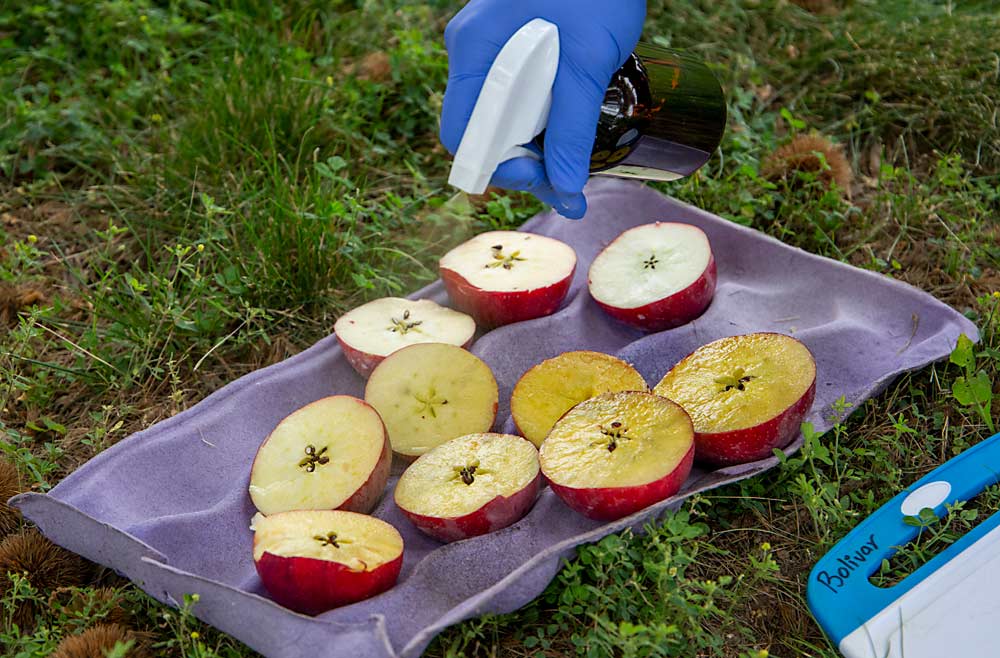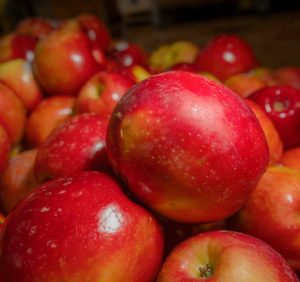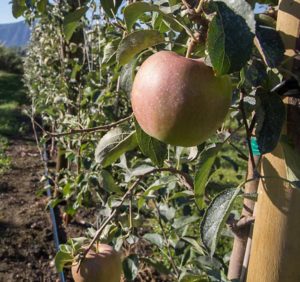
With a couple of WA 38 harvests under the industry’s collective belt, Washington growers, packers and shippers have learned a lot more about how to be successful with the apple marketed as Cosmic Crisp.
So, with the fourth commercial harvest approaching, Good Fruit Grower reached out to a few industry professionals to share their top advice.
“The industry, as a whole, doesn’t get to work (together) on new varieties very often and, with Cosmic Crisp, we got to all do it at the same time,” said Chris Hargrave, the fruit storage and quality manager at Yakima Fruit and Cold Storage. “We need this cooperation, this opportunity to work together to find what works best. We, as an industry, have a lot of Cosmic Crisp coming off the trees in the future, and we are all in it together.”
Resources on Washington’s newest apple abound, from Washington State University, the Washington Tree Fruit Research Commission and Proprietary Variety Management, the company commercializing the Cosmic Crisp program. That’s important, but so is gathering as an industry to talk about what’s working, said Matt Miles, process improvement manager at Allan Bros. and also a member of the research commission. Miles, Hargrave and others interviewed for this article are part of an industry working group sharing WA 38 experiences, with the goal of making the variety successful for everyone.
In the orchard
Harvest timing has been the subject of much hand-wringing in recent years, as growers try to achieve adequate starch clearing and color development without risking the greasiness that can develop with more mature fruit.
“You want to start between a 2.0 and 2.5 (on the starch scale developed by the research commission), but the background color is often not breaking until the fruit is closer to 2.7 or 3,” said Brad Newman of Cowiche Growers, a cooperative of growers in the Upper Yakima Valley. Location likely matters in how to interpret maturity indices, he said, and what works in the Columbia Basin may not be optimal in Tieton, but with each harvest, growers and packers are getting to know their own orchards better.
While some people interpreted the 2.0 starch as an average, it’s better to think of it as a minimum, Miles said. Last year, PVM set the threshold at 1.5, while the research commission recommended 2.0.
“Green fruit starches don’t convert well into fruit that tastes good or has good texture, especially if they are forced,” Miles said.
In 2021, many growers were tempted to harvest on the earlier side of that starch scale, to avoid greasiness, but some lots of fruit then struggled to get to the 5.0 starch clearing required to market fruit by the late November release date, Hargrave said.
As for the greasiness issue, WSU studies and industry experience suggest that it’s less of a concern in more mature trees — and the industry experienced less greasiness in 2021 compared to 2020, Miles said.
“There’s a lot of variability in second- and third- and fourth-leaf fruit,” Newman said. “We have to be careful not to make judgments on this young fruit, because it may not be a factor a couple years from now.”
Punctures are another area of concern, and Newman and Miles agreed: Spend the money and clip the stems.
“There seems to be consensus from those of us with good visibility of the effect of nonclipped stems on packouts: Packouts suck when the stems are not clipped, especially if the fruit is stored long term,” Miles said.
Packaging also plays a role, Newman added.
“So many of these Cosmics do go into bags, and it’s really easy to get a puncture,” he said.
And while it’s too late for growers this year, Newman recommended controlling for thrips, as the damage does not color over in WA 38. He also cautioned that the skin is more sensitive to limb rub than it appears to be. And in some cases, “summer pruning may be recommended to enhance color to avoid any spots where a leaf has shaded the fruit,” he said.
Postharvest handling
The best news is that when WA 38 is harvested with the right timing, “these apples may be one of the more foolproof apples to store,” Newman said.
But before it heads into storage, decay management is a priority, Hargrave said.
“I found out pretty quickly, Cosmic Crisp does like to decay in the box if it doesn’t have any fungicide,” he said.
This year, the release date is Dec. 1, in recognition that the cool spring weather delayed the maturity process about 10 to 14 days, said Jill Burbery of PVM. Until Jan. 1, PVM is requiring all lots to undergo starch testing and demonstrate an average of 5.0 starch clearance before packing, just like last year.
“It is best for fruit quality, shelf life and flavor development if starch conversion is allowed to occur naturally,” she said in an email.
Hargrave recommended identifying which grower lots will go into that December marketing window, even before harvest — in his case, younger blocks or small lots of fruit — and told growers to let the fruit mature just a bit more in the orchard.
“It’s a more targeted approach to the early window,” he said. Last year’s approach was successful:“We just took them to RA, put fungicide on, and let them sit until the release date.”
The collective wisdom on 1-MCP is shifting, too.
“1-MCP does a heck of a job on Cosmics and stops them in their tracks,” Hargrave said, especially for fruit aiming for a midseason market.
He only plans to use it on fruit stored for the really long term.
“We just opened our last Cosmic room last week,” he said in early August, describing fruit stored in CA with 1-MCP. “We had a great result, no greasiness. Fruit looked good and tasted good.”
Miles said 1-MCP has its place but isn’t necessary for managing greasiness. Like Hargrave, he recommends it only on fruit set to be stored over six months.
“Otherwise, save growers some money and preserve the flavor volatiles,” Miles said.
Lastly, he encouraged the industry to think of PVM’s quality program manager, Doug Carey, as a resource and “wealth of knowledge” on Cosmic Crisp handling. •
—by Kate Prengaman
Working with waxing
During the 2019 and 2020 seasons, some packers reported struggling with WA 38’s natural wax. Washington State University and industry collaborators responded by developing a protocol for getting a good wax coating onto WA 38, and it’s available online at: bit.ly/wa-38-waxing-protocol.
“The key is to have dry and clean fruit as it hits the wax brushes,” wrote Chris Hedges, postharvest information and technology transfer specialist at WSU.
Other recommendations include using a warm dunk tank to soften the apple’s natural wax, followed by the right soap — depending on each packing line’s conditions — to dissolve it.
But the ability to warm the dunk tank is not the only option, said Chris Hargrave of Yakima Fruit and Cold Storage.
“We don’t have that tool and, honestly, we’ve had a pretty good result,” he said. “We use an alkaline-based soap to strip some of that wax and calcium buildup, and we’ve found you can still get a nice wax result without heat in the dump tank.”
—K. Prengaman








Leave A Comment